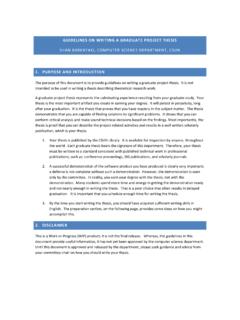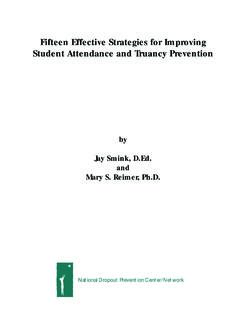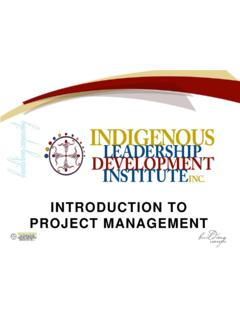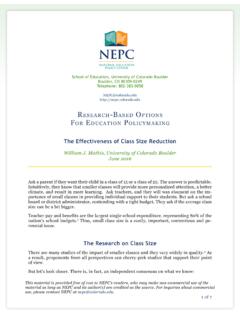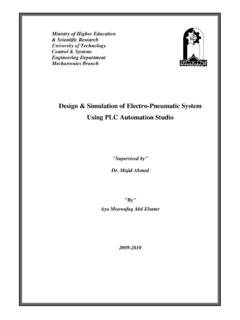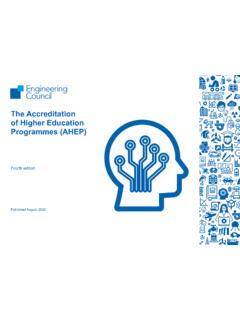Transcription of CHAPTER 1 CURRICULUM DESIGN - Project 2061
1 CHAPTER 1 CURRICULUM DESIGNAN INTRODUCTORY EXAMPLE 41 ATTRIBUTES OF CURRICULUM DESIGN 43 ESTABLISHING CURRICULUM - DESIGN SPECIFICATIONS 44 CONCEPTUALIZING A CURRICULUM DESIGN 56 DEVELOPING A CURRICULUM DESIGN 63 REFINING A DESIGNED CURRICULUM 68 LOOKING AHEAD 71 Now let us consider the idea of CURRICULUM DESIGN . As indicated by the defini-tions at the beginning of this book, the term DESIGN is used as a verb to designate aprocess (as in designing a CURRICULUM ), or as a noun to denote a particular planresulting from a DESIGN process (as in a CURRICULUM DESIGN ). Never mind that a cur-riculum is not a garden or a bridge or a traffic pattern; our purpose in this CHAPTER isto see how things play out when we apply the DESIGN practices of architects and engi-neers to the creation of new curricula. And, for the moment, let us put aside the ques-tion of precisely what a CURRICULUM is (a matter to be taken up at the beginning of thenext CHAPTER ), since the processof CURRICULUM DESIGN can be explored without first hav-ing agreement on a precise definition of purpose of this CHAPTER is to explore ideas, not to provide detailed step-by-stepinstructions on how to create an actual CURRICULUM DESIGN , let alone an actual curricu-lum.
2 It is as though, by way of analogy, the CHAPTER deals with how general designprinciples may seem to apply to designing any kind of buildings, but not to how toproduce detailed engineering plans for use in constructing actual buildings. To makethe argument easy to follow, the CHAPTER parallels the Prologue section by time, instead of the backyard garden of the Prologue, our desired end is an effec-tive K-12 CURRICULUM . Our approach need not be altogether orderly, but we would surelydo these things:DESIGNS FORSCIENCELITERACY41 CHAPTER 1 1/31/0 2:53 PM Page 41 We would become gradually clearer on why we want a new CURRICULUM . To havestudents some students? all students? learn more than they learn now? Howmuch more? Learn different things? And which things? To respond to nationalstandards or international comparisons? To raise SAT scores? How far? Toincrease attendance and the graduation rates? To have more graduates enter col-lege?
3 Certain colleges? To respond to criticism from teachers? Students? Parents?The community? State authorities? All such criticisms, or only some? Which?What if some of our intentions conflict with others? And what would get in the way of creating a new CURRICULUM ? Teacher, student,parental, or community resistance? Tradition? State laws? Lack of funds?Absence of good evidence for the benefits of change? As our goals and constraints become clear, we would identify some alternativedesign concepts to focus our thinking on CURRICULUM possibilities. A DESIGN con-cept for a CURRICULUM could be to organize instruction around inquiry at everygrade level and in every subject, or focus strongly on community issues, or inte-grate the sciences and humanities, or emphasize the development of lifelonglearning skills. On the chance of finding DESIGN concepts that may not haveoccurred to us in the beginning, we would study the CURRICULUM literature, searchthe Internet, talk to school and university educators who have been involved incurriculum DESIGN , and look at curricula in other districts.
4 We would narrow the possibilities down to a few appealing DESIGN ideas thatwould work within the DESIGN constraints we face, think over our desired goals,and choose an approach that would seem to be the best bet. Then we would develop that approach in enough detail to get started actually plan-ning the CURRICULUM . During this stage, trade-offs would have to be considered achoice, for instance, between the desire to have students cover a large amount ofmaterial and to have them develop a deep and lasting understanding of what theystudy. Our DESIGN would describe the structure of the new CURRICULUM , its content,and how it would be operated. In developing the final DESIGN , we would hope to callon expertise in CURRICULUM DESIGN (books, journals, software, and consultants). As actual implementation of the CURRICULUM DESIGN progresses, we would comeup against unexpected difficulties, forcing us to modify the original DESIGN orto choose an alternate DESIGN altogether.
5 Even with the CURRICULUM in place, the DESIGN challenge would not be the actual CURRICULUM would not match the DESIGN very well because 42 DESIGNS FORSCIENCELITERACYCHAPTER 1 CHAPTER 1 1/31/0 2:53 PM Page 42 DESIGNS FORSCIENCELITERACY43 CURRICULUM DESIGN mistakes were made in implementing the DESIGN . Or the CURRICULUM wouldmatch the DESIGN quite closely, but we would not get the results we expected. Inother words, we would discover or decide that modifications are needed, aneventuality we had anticipated and planned brief sketch obviously oversimplifies the process of CURRICULUM DESIGN even asan ideal, and of course it does not pass muster as a description of what actually hap-pens, if for no other reason than that total K-12 CURRICULUM DESIGN is rarely undertak-en. But perhaps it suffices to make our main point: the general principles of designused in other fields can apply as well to the DESIGN of curricula. On that premise, wenow proceed to explore CURRICULUM DESIGN in somewhat more OFCURRICULUMDESIGNIf designing curricula is like designing any object, process, or system in importantrespects, it follows that it has these attributes: CURRICULUM DESIGN is is not just to have a course of study.
6 Its grandpurpose is to improve student learning, but it may have other purposes as the purposes are in harmony or in conflict, explicit or implied, immediate orlong-range, political or technical, CURRICULUM designers do well to be as clear as possi-ble about what the real purposes are, so that they can respond DESIGN is be effective, CURRICULUM DESIGN must be a consciousplanning effort. It is not casual, nor is it the sum total of lots of different changes beingmade in the CURRICULUM over weeks, months, and years. It involves using an explicitprocess that identifies clearly what will be done, by whom, and DESIGN is DESIGN is not a neatly defined procedurethat can be pursued in a rigorous series of steps. At every stage of CURRICULUM designthere are opportunities for innovative thinking, novel concepts, and invention to beintroduced. Good CURRICULUM DESIGN is at once systematic and creative feet-on-the-ground and DESIGN operates on many decisions at one level must becompatible with those at the other levels.
7 A middle-school CURRICULUM DESIGN that isA Project 2061 Glossary forCurriculum DesignCurriculum:An actual sequence ofinstructional blocks operating in aschool. The sequence may cover allgrades and subjects (a K-12 CURRICULUM )or some grades and subjects (a middleschool science CURRICULUM ), and beintended for all students (a core curricu-lum) or only some students (a college-preparatory CURRICULUM ). CURRICULUM Block:A major componentof instruction from six weeks to severalyears in duration that receives separaterecognition on student features of blocks include pre-requisites, alignment with benchmarks,and evidence of instruction credibility. CURRICULUM Concept:An idea thatexpresses the character of a curriculumdesign at a succinct, abstract concepts usually only from afew sentences to a few paragraphs inlength, and perhaps addressing veryfew aspects of the DESIGN help tofocus the DESIGN DESIGN :A proposed orga-nization of particular instructional blocksover time, with instructions for how tonavigate among them.
8 Designs usuallydescribed in a few pages can beinvented de novo, elaborated from acurriculum concept, or distilled from anoperating Specifications:A delin-eation of the goals and constraints tobe taken into account in designing acurriculum. CHAPTER 1 8/23/0 10:50 AM Page 43incompatible with the elementary- and high-school designs will almost certainlyresult in a defective K-12 CURRICULUM , no matter how good each part is on its own. Bythe same token, the middle-school CURRICULUM itself cannot be effective as a wholeunless the designs of its grades are in DESIGN requires challenge is to come up with a curricu-lum that works well perfection is not its aim. In developing a DESIGN that meets com-plex specifications, trade-offs inevitably have to be made among benefits, costs, con-straints, and risks. No matter how systematic the planning or how inventive the think-ing, CURRICULUM designs always end up not being everything that everyone would designs can are many ways in which CURRICULUM designs canfail to operate successfully.
9 A DESIGN can fail because one or more of its componentsfail or because the components do not work well together. Or, the people who have tocarry it out may reject the DESIGN because they misunderstand it or find it most cases, however, CURRICULUM designs are neither wholly satisfactory nor abjectfailures. Indeed, a key element in CURRICULUM DESIGN is to provide for continuous cor-rection and improvement, both during the DESIGN process and DESIGN has DESIGN is a systematic way of going aboutplanning instruction, even though it does not consist of some inflexible set of steps tobe followed in strict order. CURRICULUM decisions made at one stage are not indepen-dent of decisions made at other stages, and so the CURRICULUM - DESIGN process tends tobe iterative, various stages being returned to for reconsideration and possible modifi-cation. But recognizing the different tasks and problems at each stage is important inmaking the process work.
10 The stages, which are considered in turn in the rest of thischapter, are establishing CURRICULUM - DESIGN specifications; conceptualizing a curricu-lum DESIGN ; developing a CURRICULUM DESIGN ; and refining a CURRICULUM the fine arts, some creative work can be purely expressive, whatever the artist feels likedoing at the moment. DESIGN , though it can be equally creative, is undertaken in a con-text of purposes or goals and constraints. (Even in the fine arts, paintings, songs, andnovels usually are more or less designed, not free expressions.) Indeed, some accounts of44 DESIGNS FORSCIENCELITERACYCHAPTER 1In simple situations, designs can be optimized to give the best possibleoutcome on some single variable. Butthis is a DESIGN luxury. In complex situations, it may not be possible toarrive at any DESIGN that does better than marginally satisfy all thespecifications. The best possible designmay not fit any of the specificationswell, but attempt only to distributeadvantages and shortcomings equitablyamong all of 1 1/31/0 2:53 PM Page 44 DESIGNS FORSCIENCELITERACY45the DESIGN process begin with the DESIGN problem a situation involving somethingthat needs to be accomplished with limited means to accomplish it.

